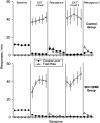Loss of alternative non-drug reinforcement induces relapse of cocaine-seeking in rats: role of dopamine D(1) receptors - PubMed (original) (raw)
Loss of alternative non-drug reinforcement induces relapse of cocaine-seeking in rats: role of dopamine D(1) receptors
Stacey L Quick et al. Neuropsychopharmacology. 2011 Apr.
Abstract
Animal models of relapse to drug seeking have focused primarily on relapse induced by exposure to drugs, drug-associated cues or contexts, and foot-shock stress. However, relapse in human drug abusers is often precipitated by loss of alternative non-drug reinforcement. The present experiment used a novel 'resurgence' paradigm to examine relapse to cocaine seeking of rats as a result of loss of an alternative source of non-drug reinforcement. Rats were first trained to press a lever for intravenous infusions of cocaine. Next, cocaine deliveries were omitted and food pellets were provided for an alternative nose-poke response. Once cocaine seeking was reduced to low levels, food pellets for the alternative response were also omitted. Cocaine seeking increased with the loss of the alternative non-drug reinforcer (ie, resurgence occurred) despite continued extinction conditions. The increase in cocaine seeking did not occur in another group of rats injected with SCH 23390 before the loss of the alternative reinforcer. These results suggest that removal of an alternative source of reinforcement may induce relapse of cocaine seeking and that the dopamine D(1) receptor may have a role in this effect.
Figures
Figure 1
Resurgence of cocaine seeking. Lever pressing (cocaine) and nose poking (food) for the control and SCH 23390 groups across experimental phases. When an alternative source of food reinforcement was removed during the resurgence and resurgence 2 conditions, rates of extinguished lever pressing for cocaine increased for the control group, but not for the SCH 23390 group. Data are from the last five sessions of the baseline and the two extinction+food phases and from the first five and three sessions of the resurgence and resurgence 2 phases, respectively.
Figure 2
Within-session patterns of responding. Cumulative lever presses across successive 2-min bins of the first resurgence session for the control and SCH 23390 groups. Similar data for the last session of exposure to the extinction+food phase (combined across groups) are provided for comparison. Lever pressing for the control and SCH 23390 groups did not differ until the 4th 2-min bin. In addition, lever pressing for the SCH 23390 continued to occur at a low rate throughout the session, as was true for the last extinction+food session.
Similar articles
- Higher rate alternative non-drug reinforcement produces faster suppression of cocaine seeking but more resurgence when removed.
Craig AR, Nall RW, Madden GJ, Shahan TA. Craig AR, et al. Behav Brain Res. 2016 Jun 1;306:48-51. doi: 10.1016/j.bbr.2016.03.026. Epub 2016 Mar 14. Behav Brain Res. 2016. PMID: 26988268 Free PMC article. - Cocaine seeking and taking: role of hippocampal dopamine D1-like receptors.
Xie X, Wells AM, Fuchs RA. Xie X, et al. Int J Neuropsychopharmacol. 2014 Sep;17(9):1533-8. doi: 10.1017/S1461145714000340. Epub 2014 Mar 21. Int J Neuropsychopharmacol. 2014. PMID: 24655895 Free PMC article. - Resurgence of sucrose and cocaine seeking in free-feeding rats.
Shahan TA, Craig AR, Sweeney MM. Shahan TA, et al. Behav Brain Res. 2015 Feb 15;279:47-51. doi: 10.1016/j.bbr.2014.10.048. Epub 2014 Nov 15. Behav Brain Res. 2015. PMID: 25446761 Free PMC article. - Contribution of a mesocorticolimbic subcircuit to drug context-induced reinstatement of cocaine-seeking behavior in rats.
Lasseter HC, Xie X, Arguello AA, Wells AM, Hodges MA, Fuchs RA. Lasseter HC, et al. Neuropsychopharmacology. 2014 Feb;39(3):660-9. doi: 10.1038/npp.2013.249. Epub 2013 Sep 20. Neuropsychopharmacology. 2014. PMID: 24051899 Free PMC article. - Chronic restraint stress during withdrawal increases vulnerability to drug priming-induced cocaine seeking via a dopamine D1-like receptor-mediated mechanism.
Ball KT, Stone E, Best O, Collins T, Edson H, Hagan E, Nardini S, Neuciler P, Smolinsky M, Tosh L, Woodlen K. Ball KT, et al. Drug Alcohol Depend. 2018 Jun 1;187:327-334. doi: 10.1016/j.drugalcdep.2018.03.024. Epub 2018 Apr 22. Drug Alcohol Depend. 2018. PMID: 29705546 Free PMC article.
Cited by
- Lever-press duration as a measure of frustration in sucrose and drug reinforcement.
Vasquez TES, McAuley RJ, Gupta NS, Koshy S, Marmol-Contreras Y, Green TA. Vasquez TES, et al. Psychopharmacology (Berl). 2021 Apr;238(4):959-968. doi: 10.1007/s00213-020-05742-2. Epub 2021 Jan 9. Psychopharmacology (Berl). 2021. PMID: 33420805 Free PMC article. - Resurgence Following Higher or Lower Quality Alternative Reinforcement.
Shahan TA, Sutton GM, Van Allsburg J, Avellaneda M, Greer BD. Shahan TA, et al. J Exp Anal Behav. 2024 Mar;121(2):246-258. doi: 10.1002/jeab.904. Epub 2024 Feb 8. J Exp Anal Behav. 2024. PMID: 38329150 - Some Factors Modulating the Strength of Resurgence After Extinction of an Instrumental Behavior.
Winterbauer NE, Lucke S, Bouton ME. Winterbauer NE, et al. Learn Motiv. 2013 Feb 1;44(1):60-71. doi: 10.1016/j.lmot.2012.03.003. Learn Motiv. 2013. PMID: 23515657 Free PMC article. - Resurgence and downshifts in alternative reinforcement rate.
Shahan TA, Browning KO, Nist AN, Sutton GM. Shahan TA, et al. J Exp Anal Behav. 2020 Sep;114(2):163-178. doi: 10.1002/jeab.625. Epub 2020 Aug 27. J Exp Anal Behav. 2020. PMID: 32856313 Free PMC article. - Cues Associated with Alternative Reinforcement During Extinction Can Attenuate Resurgence of an Extinguished Instrumental Response.
Trask S. Trask S. Learn Behav. 2019 Mar;47(1):66-79. doi: 10.3758/s13420-018-0339-9. Learn Behav. 2019. PMID: 30054852 Free PMC article.
References
- Alleweireldt AT, Weber SM, Kirschner KF, Bullok BL, Neiswander JL. Blockade or stimulation of D1 dopamine receptors attenuates cue reinstatement of extinguished cocaine-seeking behavior in rats. Psychopharmacology (Berl) 2002;159:284–293. - PubMed
- American Psychiatric Association . American Psychiatric Association: Washington, DC; 1994. Diagnostic and statistical manual of mental disorders: Fourth edition; pp. 175–183.
- Anderson KG, Velkey AJ, Woolverton WL. The generalized matching law as a predictor of choice between cocaine and food in rhesus monkeys. Psychopharmacology (Berl) 2002;163:319–326. - PubMed
- Bickel WK, Madden GJ, Petry NM. The price of change: the behavioral economics of drug dependence. Behav Ther. 1998;29:545–565.
- Bouton ME. Context and behavioral processes in extinction. Learn Mem. 2004;11:485–494. - PubMed
Publication types
MeSH terms
Substances
LinkOut - more resources
Full Text Sources
Other Literature Sources
Miscellaneous

